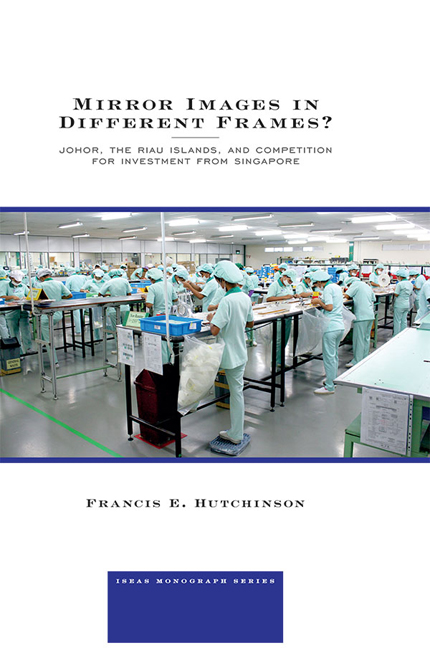 Mirror Images in Different Frames?
Mirror Images in Different Frames? Book contents
- Frontmatter
- Contents
- List of Tables
- List of Figures
- Editorial Note
- Acknowledgements
- About the Author
- List of Acronyms
- 1 Introduction
- 2 Theoretical Framework
- 3 “Internal State Architecture” and Incentive Structures for Meso-Level Leaders
- 4 The Cases: Johor and the Riau Islands
- 5 Conclusion
- Endnotes
- References
5 - Conclusion
Published online by Cambridge University Press: 15 November 2017
- Frontmatter
- Contents
- List of Tables
- List of Figures
- Editorial Note
- Acknowledgements
- About the Author
- List of Acronyms
- 1 Introduction
- 2 Theoretical Framework
- 3 “Internal State Architecture” and Incentive Structures for Meso-Level Leaders
- 4 The Cases: Johor and the Riau Islands
- 5 Conclusion
- Endnotes
- References
Summary
This book has sought to shed light on the circumstances under which sub-national governments choose to pursue economic growth and structural transformation. This was done by comparing and contrasting the case of Johor and the Province of the Riau Islands. These two territories had very similar economic models, prioritized the same sector and have also sought to attract investment from the same source. Furthermore, both were constituent parts of countries with similar economic policy frameworks and centralized political systems. However, following a critical juncture, Indonesia proceeded to decentralize power and responsibilities to the sub-national level. The incentive structures facing meso-level leaders in the country evolved as a consequence. Malaysia, for its part, proceeded in the opposite direction, proceeding to centralize more tasks at the federal level.
To this end, Johor and the Riau Islands were analysed over three time periods: 1990–97, when their national contexts were the most similar; 1998–2003, when their national contexts were in transition; and 2004–13, when they had matured and new incentive structures were in place that led to important divergences.
This exercise has yielded the following insights.
The arguments put forward by many proponents of decentralization and, in particular, the first generation fiscal federalists do not apply to either Malaysia or Indonesia. First, it is very difficult for most of the underlying conditions to be met for there to be effective and credible “competition” between states and provinces for investment. While criteria such as the free movement of labour and capital within national borders or hard budget constraints for sub-national governments are relatively easy to satisfy, others such as autonomy for sub-national governments or the institutionalized allocation of political authority are much more difficult to obtain. Second, the contention advanced by the second generation fiscal federalists that the “benevolent” nature of meso-level leaders cannot be assumed is also borne out by this analysis. Despite meso-level leaders in Indonesia receiving more responsibilities and the overall movement of the country's governance structure in a more “market-preserving” direction, we did not always see constructive and determined attempts to promote economic growth.
The framework proposed by the second generation fiscal federalists (SGFF) provided more traction. Thus, an analysis of the revenue base of the Johor and Riau Island governments has proven more instructive. Of the two territories, Johor operates in a fiscal context more espoused by the SGFF school.
Information
- Type
- Chapter
- Information
- Mirror Images in Different Frames?Johor, the Riau Islands, and Competition for Investment from Singapore, pp. 129 - 132Publisher: ISEAS–Yusof Ishak InstitutePrint publication year: 2015